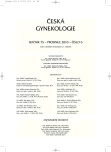Nalbuphine at maternal analgesia
Authors:
B. Vavřinková; T. Binder; J. Horák
Authors‘ workplace:
Gynekologicko-porodnická klinika 2. LF UK a FN Motol, Praha, přednosta doc. L. Rob, CSc.
Published in:
Ceska Gynekol 2010; 75(6): 563-568
Overview
Objective:
Comparison between particular methods of obstetrics analgesia, their analgetic efects and influence on progress of delivery and postpartum adaptation of fetus.
Design of the study:
Prospective study.
Setting:
The Department of Gynecology and Obstetrics of the Teaching Hospital and the 2nd Medical Faculty of the Charles University in Prague.
Methods:
A prospective study of 644 patients who received intravenous increments of nalbuphine (196 women) or epidural analgesia (217 women) or pethidin (231 women). Assessment of maternal analgesia, satisfaction was carried out. Apgar scores and resuscitative measures required for the neonate were noted at delivery.
Results:
The best analgetic effect was in the group with using peridural analgesia, where max. score was 3. The highest value was in the group of women who received pethidin. The most decrease of score after aplication of analgesia was in group with epidural analgesia, the least decrease of score was in group with pethidin. The Apgar score at 1. minute was the lowest in the group with epidural analgesia, the highest score was in the group with nalbuphine.
Conclusion:
The mixed agonist/antagonist narcotic analgesic like nalbuphine have the place in clinical practice. The obstetric analgesia is very common in obstetrics practice. The epidural analgesia is very popular but not everytimes accessible. Nalbuphine is the option who is analgetic effective and have minimal side-effect.
Key words:
analgesia, pain, delivery, opiate.
Sources
1. Caldwell, J.,Wakile, LA., Notarini, LJ. Maternal and neonatal disposition of pethidine in childbirth. A study using quantitative gaschromatography. Life Sci, 1978, 22, p. 289.
2. Gal, JT., DiFazio, CA., Mosiski, J. Analgesic and respiratory depressant activity of nalbuphine – a comparison with morphine. Anesthesiology, 1982, 57, p. 367.
3. MacAteer, EJ., Cattermole, RW., Loughnann, BA., Frank, M. Patient controlled analgesia in labour: a comparison of nalbuphin and pethidin. Anaesthetic Research Society, Manchester.
4. Morrison, JC., Whybrew, WD., Rosser, SI. Metabolites in the fetal and maternal serum. Am J Obstet Gynecol, 1976, 126, p. 390.
5. Romagnoli, AA., Keats, S. Ceiling effect for respiratory depression by nalbuphine. Clin Pharmacol Ther, 1980, 27, p. 478.
6. Rushman, GB., Davies, NJ., Atkinson, RS. A short history of anaesthesia. The first 150 years. London? Butterworth-Heinemann, 1996.
7. Shah, M., Rosen, M., Vickers, MD. Effect of premedication with diazepam, morphine or nalbuphine on gastrointestinal motility after surgery. Brit J Anaest 1984, 56, p. 1235-1238.
Labels
Paediatric gynaecology Gynaecology and obstetrics Reproduction medicineArticle was published in
Czech Gynaecology

2010 Issue 6
Most read in this issue
- Vulvodynia and the possibility of its management
- Operation procedures in female sterilisation
- Asherman’s syndrome II – therapy, methods of guidance, prevention of readhesion processs, complications and results of therapy
- Nalbuphine at maternal analgesia
